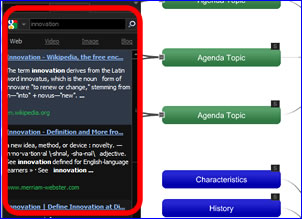 What does the future of mind mapping software look like? What recent developments in visual mapping technology are bellwethers for future capabilities? Here is one perspective: It will become a very powerful tool for conducting research, sharing the results with others and taking action on your findings.
What does the future of mind mapping software look like? What recent developments in visual mapping technology are bellwethers for future capabilities? Here is one perspective: It will become a very powerful tool for conducting research, sharing the results with others and taking action on your findings.
What do Smart Map Parts, Spinscape and the SharePoint version of MindManager have in common? They are all attempts to use mind maps as a research tool, connecting mind mapping software with data stores wherever they are – whether that data is on your corporate network, Google or your personal Evernote database – searching them and manipulating the resulting data within a visual map format.
The “information scalpel”
I predict that these tools will become more powerful and more flexible over time, an “information scalpel” that will enable sophisticated searching of information stores and flexible manipulation of the results. Some possibilities include:
- Boolean searches (search for A and B but not C),
- Limiting searches say to a specific kind of data, such as news or blogs,
- Searching other online stores of information, such as Wikipedia, Google+, Wolfram Alpha and industrial directories
- Connections to other types of corporate databases, in addition to SharePoint
- A Smart Map Part builder, so you can easily construct and modify tools to search those information stores that are most important in your industry or profession
- Storing and auto-updating search results on a scheduled basis, which would be useful for topic monitoring and competitive analysis
- Auto-notification when search results are located that meet certain criteria
- Tagging specific topics and search results and forwarding them to others on your work team for action
 In addition, the ability to review search results and only add certain entries to your mind map is a capability that will become more important in the near future. Currently, Mindjet’s Smart Map Parts for Mind Manager deliver all search results into your mind map. It’s up to you to delete those that aren’t relevant to your needs. A better approach would be to conduct searches and load the results into a side panel or dialog box near the work space, where the user can decide which results are relevant and worthy of being added to your map. This is the approach taken by Spinscape, a web-based mind mapping application, and I think it makes a lot of sense. This kind of functionality will becoming increasingly important, as information managers continue to struggle with information overload.
In addition, the ability to review search results and only add certain entries to your mind map is a capability that will become more important in the near future. Currently, Mindjet’s Smart Map Parts for Mind Manager deliver all search results into your mind map. It’s up to you to delete those that aren’t relevant to your needs. A better approach would be to conduct searches and load the results into a side panel or dialog box near the work space, where the user can decide which results are relevant and worthy of being added to your map. This is the approach taken by Spinscape, a web-based mind mapping application, and I think it makes a lot of sense. This kind of functionality will becoming increasingly important, as information managers continue to struggle with information overload.
The integrated browser with the ability to drag and drop web content also helps to transform mind mapping software into a powerful research tool. It enables you to search for information of interest and selectively add the most important bits and pieces to your mind map in an organized and efficient way.
What inspired me
What got me thinking about this is Radian6, a sophisticated team-based social media monitoring and campaign development tool that enables multiple people to track what’s being said about your company and its competitors, to monitor the needs that are being expressed by current and prospective customers and to take action. This powerful toolset is an information dashboard on steroids. As I looked at what Radian6 can do for organizations, I got to wondering what it would look like within a mind map environment.
Salesforce.com recently acquired Radian6. I think in the future we can expect to see some integration between MindManager and this powerful social media toolset, because Mindjet already has a smart map connector called Deal Navigator for the popular online CRM application.
That’s what I see in my crystal ball. What do you think the future of mind mapping software looks like?

Leave a Reply